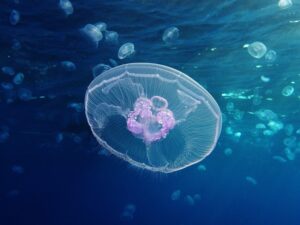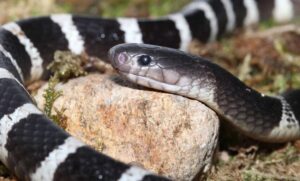Dolphins are widely considered to be some of the most intelligent and friendly animals on the planet. For this reason, people are always curious to learn and discover interesting facts about them. If you’re also interested, join KnowAllAnimals to explore “15 Interesting Facts About Dolphins” in the following article!
1. Top 15 Interesting Facts About Dolphins You Should Know
Dolphins are mammals that live in oceans and rivers and are closely related to whales. There are nearly 40 species of dolphins in the world, living in oceans and certain rivers on Earth. Their size can range from 1.2m to 9.5m, and their weight from 40kg to 10 tons. They often live in shallow seas and eat fish and squid. Dolphins are famous for their intelligence and friendliness towards humans. Let’s explore some Interesting Facts About Dolphins below:
1.1. Structure and Size
Dolphins, with their slender and flexible bodies, are well-adapted to aquatic environments. Their size ranges from 1.2m to 9.5m, and their weight from 40kg to 10 tons. A dolphin’s eyes are located near its snout, giving it a wide field of vision and allowing it to move easily in the water.
They have a small head and a long, pointed snout with conical teeth that help them hunt prey effectively. A dolphin’s body is covered in a layer of blubber and thick skin, which helps them stay warm and protects them from harsh weather and predators.
Dolphins breathe with lungs and use a blowhole on the top of their head for respiration. They can also produce sounds to communicate with other dolphins. With their keen eyesight and senses, dolphins often create unique sounds in the underwater world.
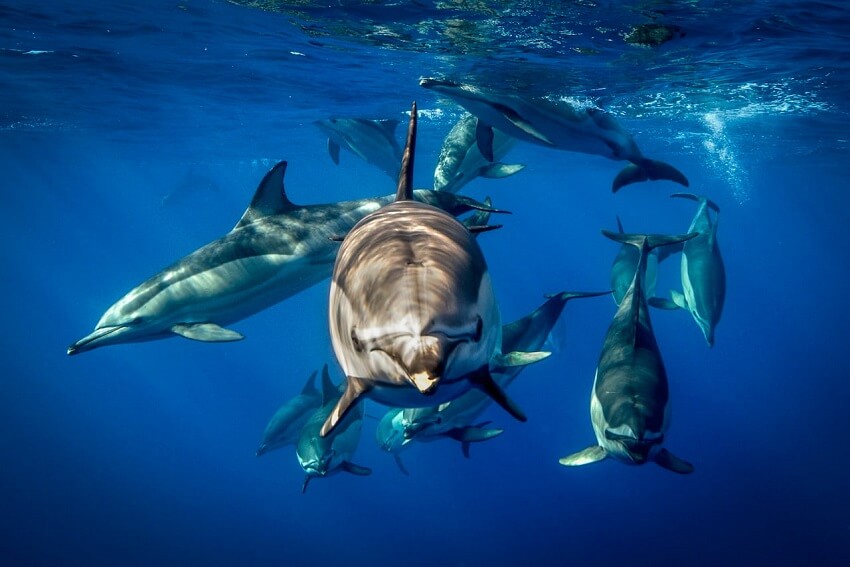
1.2. List of Dolphin Species
There are nearly 40 species of dolphins belonging to 17 genera that live in the world’s oceans and a few rivers. Here are some common dolphin species we want to introduce:
- Bottlenose Dolphin: The most common type of dolphin, living in most seas around the world and often used in circus performances.
- Killer Whale: This species of killer whale lives in pods and is the largest species in the oceanic dolphin family.
- Irrawaddy Dolphin: This dolphin species was first found and described in 1846 and is often pink or grayish-pink.
- Amazon River Dolphin (Pink Dolphin): The largest species of river dolphin, often pink or grayish-pink.
- Spinner Dolphin: This dolphin species mainly lives in the bottom layer of the water and is an egg-laying species. (Note: The user’s text seems to have a factual error here. Spinner dolphins are mammals that give birth to live young, not lay eggs. The original Vietnamese text seems to be mixing information from different animals. The English translation corrects this by using the name “Spinner Dolphin” which is a live-bearing mammal.)
- Humpback Dolphin: The humpback dolphin has a robust body and is a type of ornamental fish that lives at all water depths. (Note: The user’s text also seems to have a factual error here. Humpback dolphins are not ornamental fish. The translation corrects this by using the correct name.)
1.3. Dolphin Anatomy
Dolphins have a long, streamlined, spindle-shaped body, which helps them move quickly through the water. Their tail flukes are used to propel them while swimming, while their pectoral fins and entire tail help steer their movement. A dolphin’s skin often has gray spots, and its belly is usually a lighter color.
The dolphin’s head has a biological sonar device in its forehead. Some species have long, developed teeth that form a distinct beak. Dolphins breathe through a blowhole on the top of their head. A dolphin’s body has no hair except for a few hairs on its snout when it is first born, which it quickly loses.
A dolphin’s genitalia are located on the underside of its body. Male dolphins have two genital slits, one containing the penis and the other the anus, while female dolphins have one genital slit containing both the clitoris and the anus.
Recent research shows that dolphins can also suffer from type 2 obesity, just like humans, which opens up an opportunity to study the disease and treatment for both species.
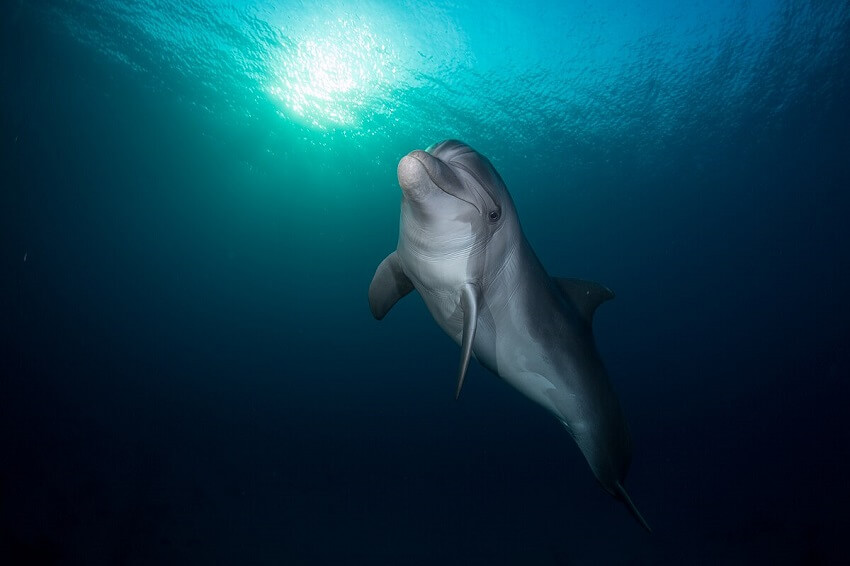
1.4. Dolphin Eating and Reproduction Habits
Dolphins are omnivorous, and their diet changes with the seasons. Some dolphin species have a habit of migrating to find food during certain seasons.
They can eat in both bottom and mid-water regions, digesting both vertebrates and invertebrates. A dolphin’s common food includes small fish, shrimp, and other invertebrates.
Dolphins reproduce by giving birth to live young and nursing them. The reproductive organs are located inside the body, and after giving birth, they feed their young milk through their teats for about 11 months before the calf separates.
1.5. Dolphins Lack a Sense of Smell
Dolphins are well-known for their sharp hearing, but interestingly, they have no sense of smell. Although they have olfactory regions, they lack an olfactory nerve. Do they have a sense of taste? In reality, they can only perceive the taste of salt.
A dolphin’s eyesight is well-developed, and they can perceive frequencies up to 10 times higher than humans can. They also use hearing for biological sonar, a special ability they possess. Despite having small earholes, they primarily hear with their lower jaw.
A dolphin’s sense of touch is especially well-developed on its skin, but they lack the ability to smell. They do prefer certain types of food and use the taste of water to sense their environment.
The Boto river dolphin has small bristles on its snout that may act as a tactile system to compensate for its poor eyesight.
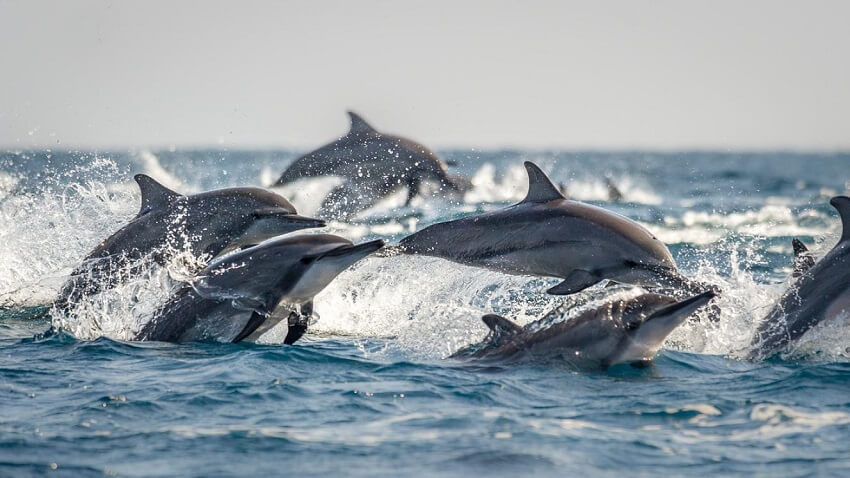
1.6. Exploring the Intelligence of Dolphins
Dolphins are known for their complex social behaviors. They organize herds, strategize for hunting, and assign tasks to scout for enemies. They use self-taught skills to hunt more effectively and pass this knowledge on to the next generation. It can be said that dolphins have a “super-cognition” ability similar to humans, showing empathy and using language.
Dolphins, as members of the order Cetacea, have exceptionally developed brains with high levels of folds and neuron density. This ability suggests that dolphins have an intelligence level comparable to that of primates, especially in communication and social interaction.
1.7. Male Dolphins Form Alliances to Win Over Females
In the dolphin community, male dolphins often form stable alliances for many years to increase their chances of winning over females. Researchers have noted that in Shark Bay, Western Australia, bottlenose dolphins have developed complex strategies to compete in the battle for mates.
These male dolphin groups are divided into three smaller groups with distinct roles: a “persuasion” group to attract females, a “stealing” group to take females from other herds, and a group that works together to protect their females. This type of organization demonstrates the intelligence and flexibility of dolphins in creating diverse tactics to win in the competition for mates.
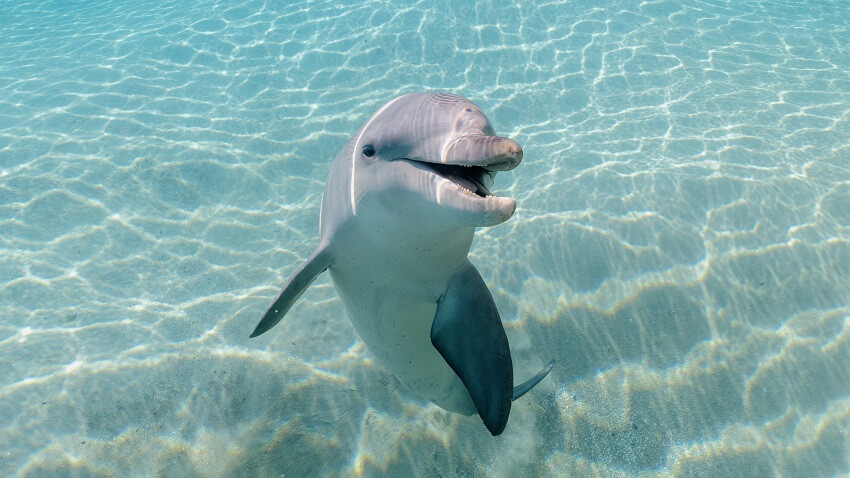
1.8. Dolphins Communicate with Whistles
Experiments recording hundreds of dolphin whistles have confirmed that they use whistles to call each other by name. This research was conducted in Sarasota Bay, Florida, from 1984-2009, and recordings were also made of dolphins in captivity. Scientists Stephanie King and her colleagues at the University of St Andrews performed a detailed analysis of their behavior and sounds.
The results showed that dolphins use their own whistles to clearly establish contact with other individuals, demonstrating their rich communication abilities in the underwater world.
1.9. Dolphins Have the Longest Memory in the Animal Kingdom
After a long experiment, American scientists have discovered the longevity of a dolphin’s social memory. A newly published study shows that this marine animal has the longest memory in the entire animal kingdom.
The experiment was conducted at the Institute for Mind and Biology in Chicago. In this experiment, a dolphin named Bailey was separated from his companion Alice for over 20 years. However, when he received a signal from Alice through a loudspeaker, Bailey still recognized and responded to the signal. This proves that dolphins have the longest memory in the animal kingdom, far surpassing elephants, whose long-term memory lasts for about 10 years.
American researchers are continuing the experiment to see if dolphins can recognize their “relatives” through their signature whistles.
1.10. Dolphins Recognize Each Other Through Urine
Scientists have discovered that dolphins use urine to identify their friends. While humans can recognize each other by face, bottlenose dolphins identify each other by their unique signature whistles. But what’s new is that they also use urine to recognize their peers.
The VICE project, a research collaboration between the University of St Andrews in Scotland and Stephen F. Austin University in Texas, conducted a study on dolphin calls. The scientists used captive bottlenose dolphins at Dolphin Quest in Bermuda and Hawaii for the experiment.
The scientists observed that dolphins moved quickly through each other’s urine with their mouths wide open, suggesting they could glean some information from the urine. They then conducted an experiment where they placed one dolphin’s urine in a cup and then played the signature whistle of a different dolphin. The results showed the test dolphin moving away from that spot because the urine did not match the whistle of the friend it knew.
In another test, a dolphin swam toward the speaker playing its friend’s signature whistle after a urine sample was collected. This was a surprising discovery about a vertebrate’s ability to recognize friends through urine.

1.11. Dolphins Can Survive Without Sleep
A recent study revealed a surprising ability of dolphins: they can survive for many days, or even weeks, without sleep. But how do they do this?
Dolphins have a special sleep mechanism that allows one half of their brain to rest while the other half remains awake—a process known as “unihemispheric sleep.” This mechanism helps dolphins avoid the risk of drowning, while also keeping them alert to danger and promoting brain development.
Additionally, dolphins use the toxins from their prey as a kind of “drug.” Although this toxin can be fatal, in small doses, it has a narcotic effect. A BBC documentary recorded a scene of dolphins playing with a pufferfish for a long time, after which they continued to behave in an unusual way.
1.12. Dolphins Evolved from a Land Animal
Dolphins are mammals that originated from a dry land environment.
They are able to understand and group objects that are similar, and they also understand and respond to sounds and images, just like humans.
The ancestors of dolphins once lived on land and were carnivorous, but about 50 million years ago, they adapted to the aquatic environment and evolved into the marine mammals we see today.
Although they are friendly, dolphins also have some unique behaviors, such as tossing their young into the air to kill them, which is part of their reproductive behavior.
1.13. Dolphins Can’t Breathe Underwater But Don’t Drown While Sleeping
Dolphins cannot breathe underwater but do not drown while they sleep. They sleep in a unihemispheric pattern, where one half of the brain rests while the other half stays awake. This helps them maintain natural activities like swimming and breathing while sleeping, keeping them safe from predators.
Dolphins take only half a second to exhale all the air in their lungs, and then need another half a second to inhale new oxygen. This helps them conserve energy and stay alert when necessary.
1.14. Most Dolphins Don’t Chew Their Food
Dolphins can’t chew their food. Their teeth are evolved to firmly grip their prey. They often shake or rub their food to tear it into smaller pieces before swallowing.
The theory is that since their prey is often small fish, dolphins need to grab them quickly so they don’t escape. They skip chewing to ensure their prey doesn’t get away.
Researchers have found that dolphins in Shark Bay form relationships based on their shared passion for using hunting tools. Dolphins can recognize their unique signature whistles and use them to attract mates.
This discovery opens up new questions about the communication abilities and the evolution of language skills in dolphins.
1.15. Dolphins Can Recognize Each Other Through Urine
Dolphins use both their signature whistles and urine to recognize their friends. This approach not only helps them identify one another but also creates a special bond between individuals.
Research has shown that dolphins not only recognize unique whistles but also use the smell and taste from urine to identify friends. This demonstrates the high level of intelligence and complex communication of this species.
This ability of dolphins has opened up new aspects of understanding how they communicate and interact with each other.

2. FAQs
1. Do dolphins recognize their peers through urine?
Yes. In addition to using whistles to recognize friends, dolphins also use their keen sense of smell to “read” the scent of urine to identify other individuals and form social bonds.
2. How do dolphins sleep without drowning?
They use a mechanism called “unihemispheric sleep,” which means only one hemisphere of the brain sleeps while the other remains awake to control breathing and maintain balance underwater.
3. How long is a dolphin’s memory?
Very impressive. Dolphins have an incredible long-term memory and can even recognize their peers after many years of separation. One experiment proved that a dolphin named Bailey remembered his friend Alice through an audio signal, even after being separated for more than 20 years.
4. From what species did dolphins evolve?
The ancestors of dolphins lived on land. They evolved from land-dwelling animals into marine species and developed unique behaviors, such as “tossing” their young out of the water.
5. Do dolphins chew their food?
No. They don’t chew; they only use their teeth to firmly grip their prey. The food is then swallowed whole, which helps increase the efficiency of their hunting.
3. Conclusion
Dolphins are not only intelligent and friendly mammals but also possess a myriad of astonishing abilities, from recognizing friends through urine and sleeping with only half of their brain to having a persistent memory and evolving from land-dwelling ancestors. We hope that these 15 Interesting Facts About Dolphins have given you a greater appreciation for and desire to learn more about the amazing and intricate world of these magnificent creatures.
References: https://en.wikipedia.org/wiki/Dolphin


